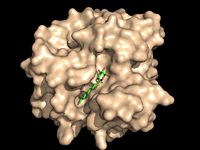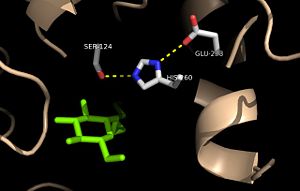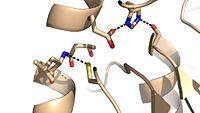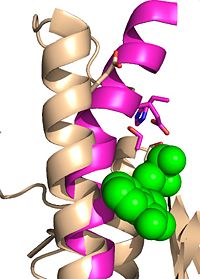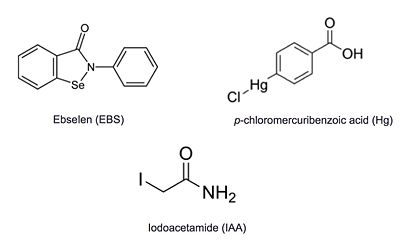Sandbox Reserved 1053
From Proteopedia
| Line 24: | Line 24: | ||
[[Image:C209.jpeg|200 px|left|thumb|'''Figure 4:''' Cys209 stabilizing kinked formation of alpha-9 helix in the native [http://www.rcsb.org/pdb/explore/explore.do?structureId=1dqz Ag85C] enzyme ]] | [[Image:C209.jpeg|200 px|left|thumb|'''Figure 4:''' Cys209 stabilizing kinked formation of alpha-9 helix in the native [http://www.rcsb.org/pdb/explore/explore.do?structureId=1dqz Ag85C] enzyme ]] | ||
| - | Due to the importance of Ag85C enzymatic activity in maintaining the integrity of the ''Mycobacteria tuberculosis'' cell wall though mycolic acid modifications, the Ag85C enzyme represents a potentially effective avenue for inhibiting cell growth. The conformational sensitivity of the active site residues, H260, E228, and S124, relies entirely upon Van der Waals interaction between C209 and L232-T 23, which can be seen in '''Figure 4'''. The C209 facilitated interaction causes the <scene name='69/694220/Alpha_9_helix/2'>α9 helix</scene> to acquire a kinked conformation that promotes optimal interaction distances between catalytic residues. As a result, C209 has been a specific target residue for Ag85C inhibition. | + | Due to the importance of Ag85C enzymatic activity in maintaining the integrity of the ''Mycobacteria tuberculosis'' cell wall though mycolic acid modifications, the Ag85C enzyme represents a potentially effective avenue for inhibiting cell growth. The conformational sensitivity of the active site residues, H260, E228, and S124, relies entirely upon Van der Waals interaction between <scene name='69/694220/C209/1'>C209 and L232-T 23</scene>, which can be seen in both the scene and '''Figure 4'''. The C209 facilitated interaction causes the <scene name='69/694220/Alpha_9_helix/2'>α9 helix</scene> to acquire a kinked conformation that promotes optimal interaction distances between catalytic residues. As a result, C209 has been a specific target residue for Ag85C inhibition. |
Revision as of 20:32, 27 April 2015
| This Sandbox is Reserved from 02/09/2015, through 05/31/2016 for use in the course "CH462: Biochemistry 2" taught by Geoffrey C. Hoops at the Butler University. This reservation includes Sandbox Reserved 1051 through Sandbox Reserved 1080. |
To get started:
More help: Help:Editing |
Background
The antigen 85 (ag85) complex in Mycobacterium tuberculosis, which is responsible for causing the disease Tuberculosis, is composed of three intracellular membrane proteins: Ag85A, B, and C. The Ag85 complex is a major component of the cell wall, with each protein catalyzing the transfer of important cell wall constituents into the membrane. [1] The cell wall of Mycobacterium tuberculosis is composed of three primary molecules: peptidoglycans, arbinogalactans, and mycolic acids. Ag85C is of particular interest due to its transfer of mycolic acids, which is one of the major components in determining cell wall integrity. The mycolic acids are responsible for forming the outermost layer of the cell wall. Mycolic acids have a long fatty acid chain and exhibit extreme hydrophobicity, which effectively creates a hydrophobic envelope surrounding the bacterium. The hydrophobic envelope created by they mycolic acids creates a barrier against small hydrophilic molecules, such as Tuberculosis antibiotics. By targeting this mycoloyltransferase activity, inhibition of Ag85C offers potential for cell wall disruption and subsequent antibiotic targeting for normally drug-resistant Mycotaberia tuberculosis. [2]
Structure
| |||||||||||
References
- ↑ Ronning DR, Klabunde T, Besra GS, Vissa VD, Belisle JT, Sacchettini JC. Crystal structure of the secreted form of antigen 85C reveals potential targets for mycobacterial drugs and vaccines. Nat Struct Biol. 2000 Feb;7(2):141-6. PMID:10655617 doi:10.1038/72413
- ↑ Jackson M, Raynaud C, Laneelle MA, Guilhot C, Laurent-Winter C, Ensergueix D, Gicquel B, Daffe M. Inactivation of the antigen 85C gene profoundly affects the mycolate content and alters the permeability of the Mycobacterium tuberculosis cell envelope. Mol Microbiol. 1999 Mar;31(5):1573-87. PMID:10200974
- ↑ Favrot L, Lajiness DH, Ronning DR. Inactivation of the Mycobacterium tuberculosis Antigen 85 complex by covalent, allosteric inhibitors. J Biol Chem. 2014 Jul 14. pii: jbc.M114.582445. PMID:25028518 doi:http://dx.doi.org/10.1074/jbc.M114.582445
- ↑ Ronning DR, Klabunde T, Besra GS, Vissa VD, Belisle JT, Sacchettini JC. Crystal structure of the secreted form of antigen 85C reveals potential targets for mycobacterial drugs and vaccines. Nat Struct Biol. 2000 Feb;7(2):141-6. PMID:10655617 doi:10.1038/72413
